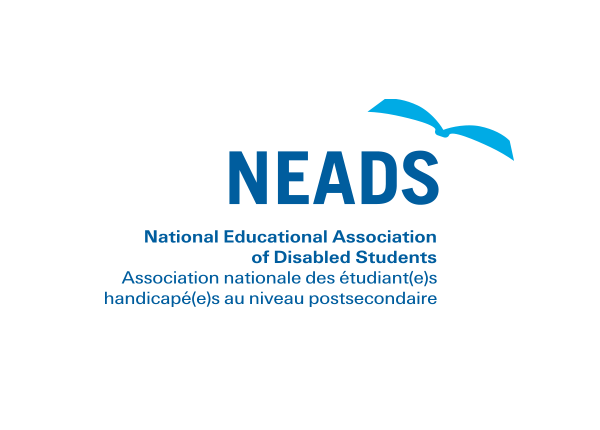What job factors enhance organization-based self-esteem (OBSE) most among employees with disabilities?
May 8, 2019
New tools for integration: Credential assessment for displaced individuals
May 30, 2019While there has been progress in advancing inclusion for students with disabilities in Canadian colleges and universities, there is still work to be done to reduce structural barriers, discrimination and alienation from access to career education and work-integrated learning, according to the Final Report of a CERIC-funded project undertaken by the National Educational Association of Disabled Students (NEADS). The report, Accessibility and Universal Design in Career Transitions Programming and Services, finds that students with disabilities need greater opportunities to build their skills and career-related experience, whether through co-op placements, mentorship or volunteering.
This NEADS report aggregates findings from a range of research that looks at different data-sets and populations of disabled students and includes a survey of post-secondary career educators. The purpose of the report is to help increase understanding of existing gaps and guide best practice models for accommodations and universal design in career education for students with disabilities. CERIC’s support allowed for an expansion of the scope of research within the landmark The Landscape of Accessibility and Accommodation for Post-Secondary Students with Disabilities in Canada project funded by Employment and Social Development Canada from 2016-2018, which is a thorough examination of current accessibility, services, accommodations, technical equipment and supports for students with disabilities at publicly funded post-secondary institutions across Canada.
Overall, the key messages related to career development that emerge from the research include:
- Accessibility and inclusion efforts in the post-secondary environment have lagged behind the evolution of the student experience and are limited to the academic (classroom and online learning) environment; in particular, accessibility in the co-curricular, professional development and work-integrated learning spaces needs to be developed.
- Students with disabilities are often lacking in non-academic experiences that can lead to employment including: summer employment, part-time work during the school year, co-op placements and internships.
- Significant transition barriers into, between, and out of levels of post-secondary education remain, with particular challenges faced by disabled students transitioning into post-secondary, and from post-secondary into the labour market.
Additional analysis for the report was done using the Statistics Canada 2012 Canadian Survey on Disability and the 2015 Canadian University Consortium study. The consortium study includes survey data on types of work experience; motivation for pursuit of higher education and career goals; and steps to prepare for employment among students with disabilities. The Canadian Graduate and Professional Student Survey (2016), which specifically focuses on graduate students with disabilities, was also examined. It includes a snapshot of the experience of Indigenous graduate students with disabilities and graduate students pursuing STEM disciplines. Collectively, this reporting on the education and employment experiences of Canadians with disabilities in college or university programs provides valuable context and insights.
Some notable findings:
- Of the 3,775,910 Canadians with disabilities aged 15 years and older, 190,290 are attending a post-secondary institution.
- University students with disabilities are younger, slightly more likely to be female, much less likely to identify as Indigenous, more likely to be an immigrant and slightly less likely to be a member of the visible minority population than non-university students with disabilities.
- The most prevalent type of disability reported among university students is pain. This type of disability is frequently reported together with mobility and/or flexibility disabilities and/or disability as a result of a mental-health condition. Mental health was the second most prevalent disability reported.
- The employment rate of Canadians aged 25 to 64 with disabilities was 49%, compared with 79% for Canadians without a disability. The difference in employment rates between persons with disabilities and those without a disability was lower among university graduates.
- Graduate students with disabilities are typically older than graduate students not reporting disabilities. They are also more likely to be enrolled in arts and humanities and less likely to be enrolled in business/management and engineering programs.
- Approximately 60% of graduating students with disabilities plan to continue with further education or career development after graduation, with 38% expected to apply to graduate school and 22% expected to apply to professional school.
- Thirty-one percent of students with disabilities say they have employment arranged for after graduation. Among those, 44% report the work as having a strong correlation with the skills and knowledge they acquired and 38% say it required their specific degree.
- Nearly all graduating students with disabilities have taken at least one step to prepare for employment after graduating, usually informally through talking with peers, parents or professors about career options.
As part of this research project, NEADS also conducted a nationwide survey in late 2018 /early 2019 of career education professionals in Canadian post-secondary institutions in order to understand their experiences working with students with disabilities. Some of the challenges noted by respondents include:
- Issues and questions students have regarding disclosure to employers;
- Lack of awareness or resources to support diverse conditions by institution or employers;
- Employers are still slow to hire people with diverse abilities due to lack of awareness, will or supports; and
- Structural barriers that exist within the institution.
The report notes that a key issue is that disability services centres on Canadian college and university campuses are funded to provide academic accommodations, but not accommodations in other learning environments. For students with disabilities, the potential for significant barriers to accessing the co-curricular learning environment exists. Disability offices do not often have the staff to devote to working with other student services portfolios, such as career educators on campus, in preparing them to work with students with disabilities.
The report encourages career educators to increase their knowledge base to support the specific challenges that students with disabilities experience and to consider how – from universal design to employment accommodations – they can better transform this knowledge into programming within their post-secondary institutions.

